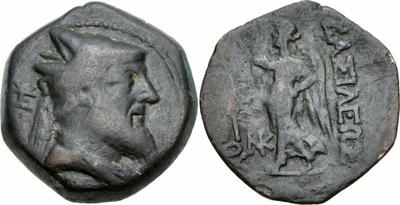'''Xerxes''' (Ancient Greek: Ξέρξης - Xerxes, Old Persian: Ḫšayāršā, Armenian: Šavarš).
He succeeded his father Arsames I to rule both Sophene and Commagene in 228 BC, whilst his brother Orontes IV ruled Armenia.
The Satraps of Upper Media, Lower Media and Persis rebelled against king Antiochus III in 223 BC.
Also in 223 BC Achaeus, the Satrap of Asia Minor, rebelled.
By 220 BC Antiochus put down most of the rebellions, though Achaeus was not defeated until 213 BC.
All of these rebellions helps to understand the context, and motives for the subsequent actions of Antiochus on king Xerxes.
By 212 BC Antiochus III had invaded the domain of Xerxes and defeated him after laying siege to the city of Arsamosata. Shortly afterwards Antiochus arranged for Xerxes to marry his sister, Antiochis.
This move seems to show the power or influence Xerxes had in the region, as is attributed by his numerous coins.
However within the same year his new wife arranged to have him assassinated, thinking that Antiochus would be able to take control of Sophene. Whether Xerxes had still ruled Commagene by the time of his assassination is not known.
Xerxes is supposed to have had a son called Abdissares, this name sounds similar to "Dsariadres" which is an alternative Greek version of Zareh, the supposed General sent by king Antiochus III to overthrow Sophene in 200 BC. Aramaic inscriptions found near Lake Sevan and Zangezur in the Republic of Armenia testify that king Artaxias was not only the son of Zareh, but also an Orontid.
He succeeded his father Arsames I to rule both Sophene and Commagene in 228 BC, whilst his brother Orontes IV ruled Armenia.
The Satraps of Upper Media, Lower Media and Persis rebelled against king Antiochus III in 223 BC.
Also in 223 BC Achaeus, the Satrap of Asia Minor, rebelled.
By 220 BC Antiochus put down most of the rebellions, though Achaeus was not defeated until 213 BC.
All of these rebellions helps to understand the context, and motives for the subsequent actions of Antiochus on king Xerxes.
By 212 BC Antiochus III had invaded the domain of Xerxes and defeated him after laying siege to the city of Arsamosata. Shortly afterwards Antiochus arranged for Xerxes to marry his sister, Antiochis.
This move seems to show the power or influence Xerxes had in the region, as is attributed by his numerous coins.
However within the same year his new wife arranged to have him assassinated, thinking that Antiochus would be able to take control of Sophene. Whether Xerxes had still ruled Commagene by the time of his assassination is not known.
Xerxes is supposed to have had a son called Abdissares, this name sounds similar to "Dsariadres" which is an alternative Greek version of Zareh, the supposed General sent by king Antiochus III to overthrow Sophene in 200 BC. Aramaic inscriptions found near Lake Sevan and Zangezur in the Republic of Armenia testify that king Artaxias was not only the son of Zareh, but also an Orontid.
 |
| Coin ascribed to king Xerxes. The profile of the king on the coins of Abdissares are very similar. However they have his name on them, whilst this one just has ".....OY" |

No comments:
Post a Comment
Note: only a member of this blog may post a comment.